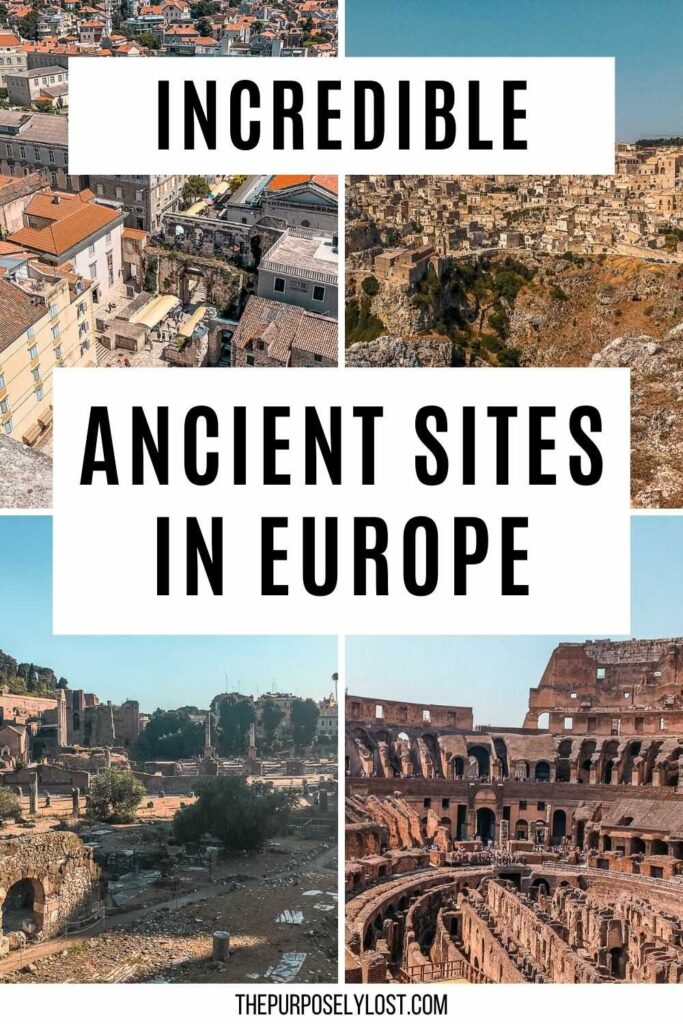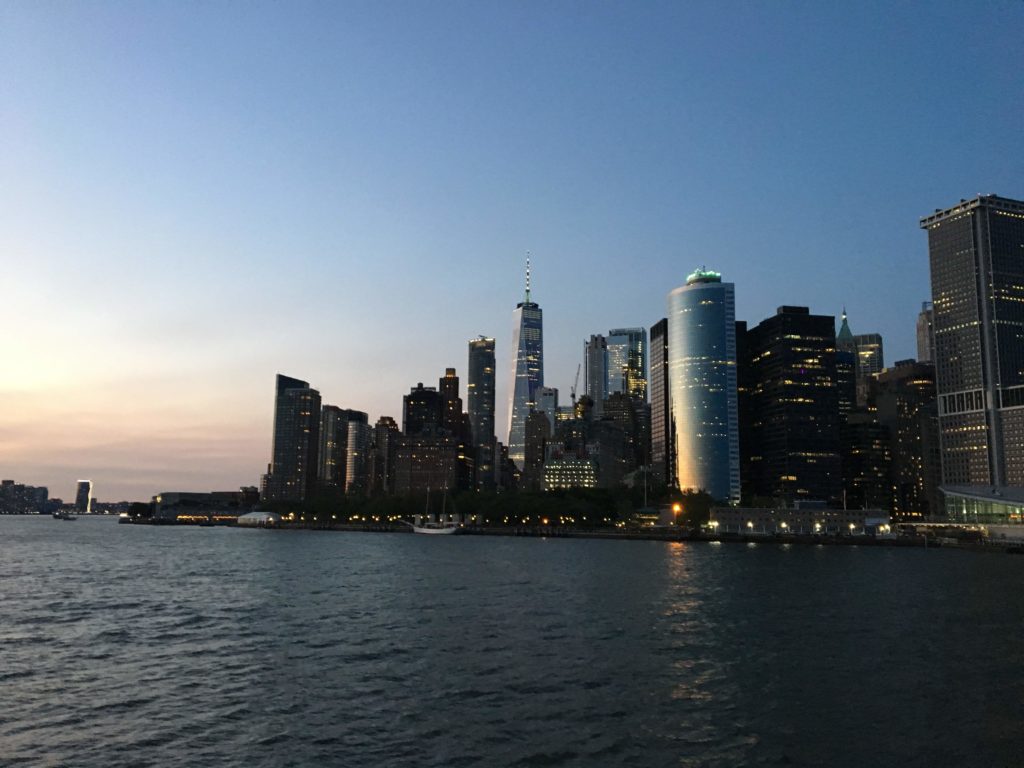Contents
- 1 Map for this guide
- 2 Dún Aonghasa
- 3 Stonehenge
- 4 The Roman Baths
- 5 Pont du Gard
- 6 Lascaux Caves
- 7 Roman Forum & Palatine Hill
- 8 Colosseum
- 9 Pantheon
- 10 Ostia Antica
- 11 Ruins of Pompeii
- 12 Herculaneum
- 13 Sassi di Matera
- 14 Teatro Greco
- 15 Mnajdra Temples
- 16 Ales stenar
- 17 Pula Arena
- 18 Diocletian’s Palace
- 19 Acropolis
- 20 Knossos
- 21 Ancient Roman Theater of Philippopolis
- 22 Ephesus
This post may contain affiliate links! I will receive a commission, at no extra cost to you, if you purchase something recommended here.
There are some parts of Europe where it feels like you’re time traveling through history. Many people have been to countries like the United Kingdom, Italy, and Greece, but far fewer have visited the ruins of some of Europe’s most important ancient civilizations.
From the Greek ruins of Acropolis and Knossos to the Roman ruins of Pompeii and Ostia Antica, these ancient places in Europe are a great way to broaden your cultural horizons and learn more about history and architecture.
Map for this guide
Make sure to save this map for easy access to all of these archaeological sites in Europe!
Western Europe
Dún Aonghasa

Dún Aonghasa is a beautiful historic site on the island of Inis Mor, one of the Aran Islands off Ireland’s coast. Dún Aonghasa is a historic fort that is over 3,000 years old; it’s built out of stone in a semi-circle perched high on the cliffs of Inis Mor.
With panoramic views spanning the Atlantic, Dún Aonghasa is worth the semi-arduous trek required to reach the fortress. Once you’ve ascended, you’ll find yourself atop a 300-foot cliff, surrounded by awe-inspiring beauty and rich history. Watch your feet on the cliffs, as there are no barriers between you and the steep drop below.
To reach the fort, you need to make your way to Inis Mor, which makes for an easy day trip from Galway. Take a bus to Rossaveal from Galway, and from there, a ferry ride to Inis Mor. The ferry lasts about 40 minutes–if you’re lucky, you might spot some dolphins! Once you’ve reached Inis Mor, there are many places where you can rent a bicycle in the village – walking is also an option. Once you arrive at the bottom of the fortress, you’ve got to lose the bike and continue on foot, as the terrain is not suitable for wheels. Don’t forget to wear appropriate shoes!
Submitted by: Jade from The Migrant Yogi
Stonehenge

Stonehenge is one of the most famous ancient sites in Europe. The prehistoric monument includes a stone circle and earthworks that archaeologists believe was built around 3000 BC to 2000 B.C. It is mind-boggling how such huge stones were brought from miles away and set up in a way to align with the summer solstice sunrise and winter solstice sunset. Stonehenge is still a mystery as experts haven’t concluded why the site was chosen or its purpose.
When you visit Stonehenge, start with the exhibition about its history at the Visitor’s Centre. Then, you can either take a bus or walk a mile to the stone circle. If you choose to walk you will see some of the other ancient places in Europe in the area. An audio tour will guide you around the stone circle.
In general, visitors must keep their distance from the stones for preservation purposes, but there are special after-hour tours that allow you to get closer.
Stonehenge is located in the English countryside, so it’s challenging to get to using public transportation. From London, you would have to take a train to Salisbury then switch to a bus. If you are not experienced driving in the U.K., it might be best to take a guided tour from London.
Submitted by: Anisa from Two Traveling Texans
The Roman Baths
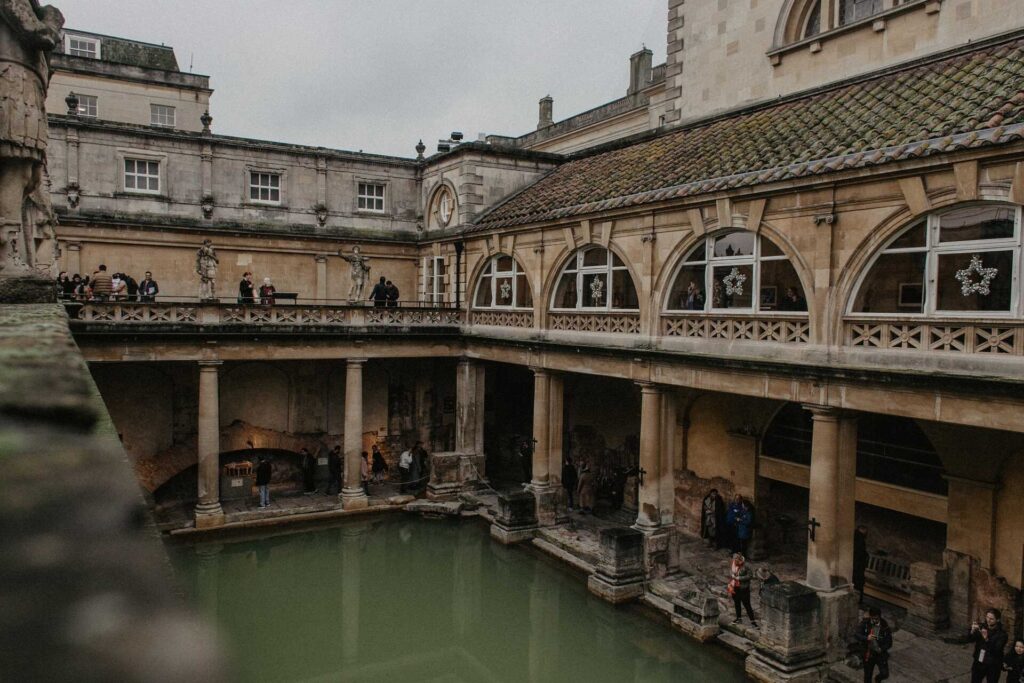
The Roman Baths are one of the most popular tourist attractions in Bath, England, and it’s one of the best-preserved examples of a Roman bathing complex. Constructed initially around 60 to 70 B.C., the series of baths were used by ancient Romans when they first occupied the area and were expanded over the years.
The Baths are made up of many bathing pools, including the Great Bath, the facility’s centerpiece. The Romans had various baths in their territory, with the baths’ primary purpose to cleanse the mind and body. In Bath, the baths were added over the centuries, with the last addition recorded in the 16th century. These Roman Baths were introduced to the UNESCO World Heritage Site list in 1987.
Today, tourists can’t swim in the original pools but can see them and hear more about their history in the onsite museum, or take afternoon tea at the Pump Room Restaurant.
A UNESCO World Heritage Site is a creation or landmark chosen for conservation by the United Nations Organization for Education, Science and Culture (UNESCO) due to its cultural, historical, scientific or natural significance. It must meet a minimum of one of ten selection criteria to be considered for the World Heritage List, and once chosen, it becomes protected for preservation by various international treaties.
Pont du Gard
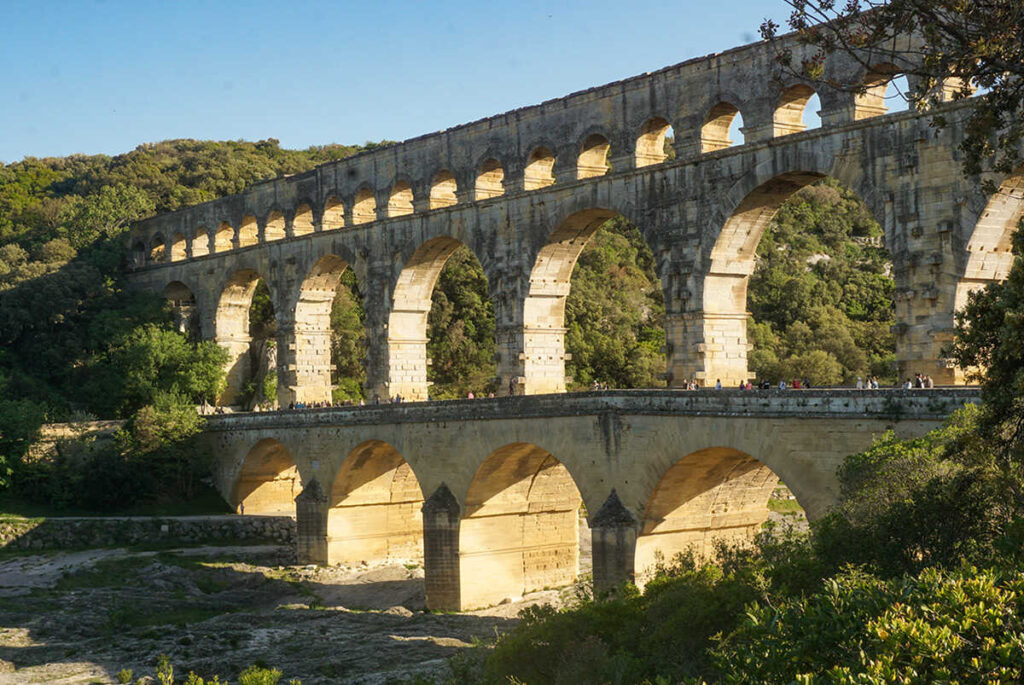
If you’re looking for famous monuments in Europe, head to the Pont du Gard in France. One of the most historic sites in France, the Pont du Gard welcomes more than a million visitors each year!
The Pont du Gard is near Nimes in the south of France and is one of the highest ancient Roman aqueducts in the world, standing at 160ft tall. Built around 50 A.D., it carried water over the Gardon River to Nimes and remains an impressive sight against the landscape.
The Pont du Gard is accessible year-round (with reduced opening hours in the winter months.) Apart from walking along the viaduct, there is also a museum to visit, and occasionally guided tours are offered, which will take you up to the very highest levels of the viaduct. It’s easily accessible from the main roads near Nimes and is well-signposted.
There is plenty of free parking available, and public events are often held within the grounds – when admission is sometimes free for all. Kids are free anytime and will love the interactive museum, and adults will enjoy walking the “Memoires de Garrigue” loop to discover the unique Mediterranean landscapes of this area.
You should allow at least a half-day for visiting. But, you could easily spend the entire day enjoying the surroundings of the aqueduct, particularly in the summer months when a swim in the gently flowing river will be too tempting to pass up!
Submitted by: Kathryn Bird from Wandering Bird
Lascaux Caves
The Lascaux Caves are a cave complex near Dordogne, renowned for its paleolithic cave paintings in southwestern France. Found close to the town of Montignac, they contain some of the best known Upper Paleolithic art, with paintings estimated to be more than 17,000 years old.
The caves are home to an incredible collection of Paleolithic art, including over 600 different paintings and more than 6,000 figures, primarily featuring large animals, humans, and geometric patterns, since the Stone Age. They were uncovered in 1940 by 18-year-old Marcel Ravidat, who was looking for his lost dog. Ravidat, along with a few friends, entered the cave through a deep shaft and found a cave wall covered with animal depictions.
Although the Lascaux Caves were initially opened to the public and added to the UNESCO World Heritage Site in 1979, it has been closed for public viewing since the 1960s due to mold growth and air pollution causing deterioration of the art. Now, only a handful of archaeologists are given access to study and monitor them to shield them from further destruction. Instead, you can catch a glimpse into the incredible works from the past with their virtual tour.
Read More
- The Most Famous Landmarks in Europe
- Incredible Religious Places in Europe
- The Best Palaces in Europe to Visit
- Your Guide to the Best European Winter Destinations
- Top Guided and Walking Tours in Europe
- The Ultimate European Summer Travel Packing List
Roman Forum & Palatine Hill
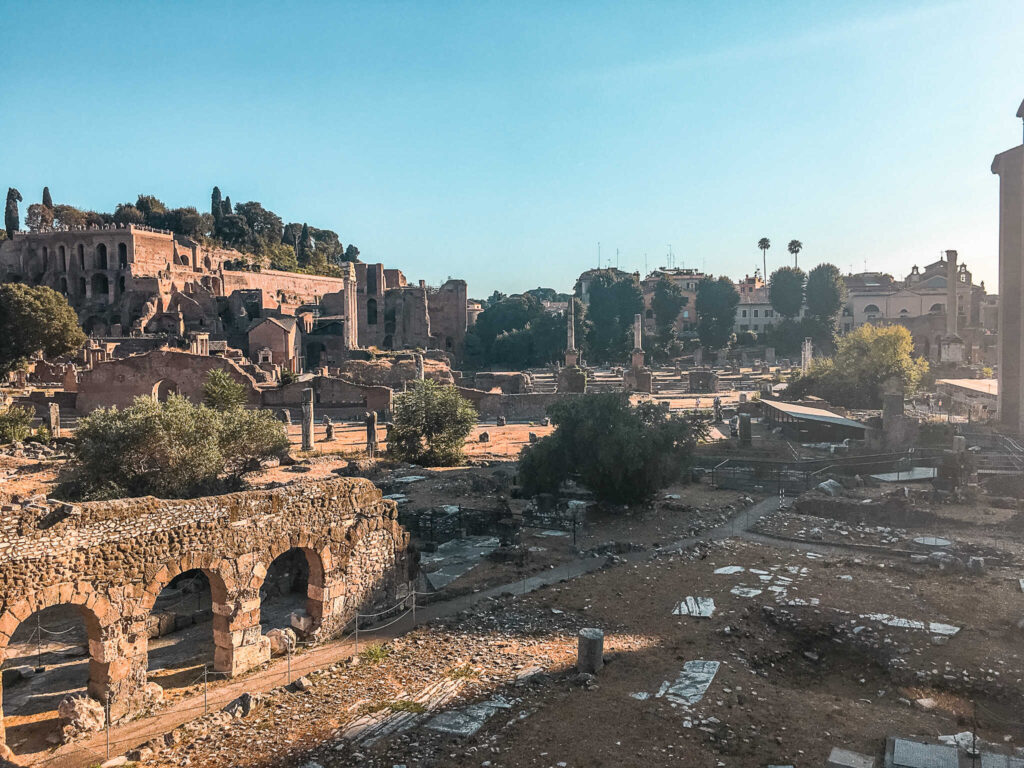
Located in what was ancient Rome’s city center, the Roman Forum is an archeological site that had been the marketplace of the capital city of the Roman Empire. Established at the height of the Roman civilization, it consists of a rectangular square surrounded by temples, government offices, and other public buildings. It was the most important economic, political and religious hub in the world for centuries, and it’s now one of the most popular places to visit in the Italian capital.
For centuries, the Roman Forum was the center of civic life and political activity in Rome, where people heard speeches and saw criminal trials. It’s an impressive location even now, with many high arches and columns towering overhead as you pass through. When you walk along the ancient sites in Europe’s streets, you can see incredible ruins like the Temple of Vespasian and Titus’s surviving columns, the triumphal Arch of Titus, and Trajan’s Market, which was a massive, open-air, four-story shopping center protected by a large portico.
You can also find Palatine Hill, the most central of the Seven Hills of Rome and one of the ancient city’s oldest areas. Many royal residences were built here, and Roman legend states that it’s the location of Lupercal, the original cave where Romulus and Remus were found and kept alive by the she-wolf Lupa.
Today, the Roman Forum is open to the public. You can explore this ancient places in Europe’s buildings, monuments, and statues, as well as view artifacts at the Palatine Museum. Walking around the site is free and open every day, or you can take a guided walking tour of the grounds to learn more about the history of what remains.
Colosseum
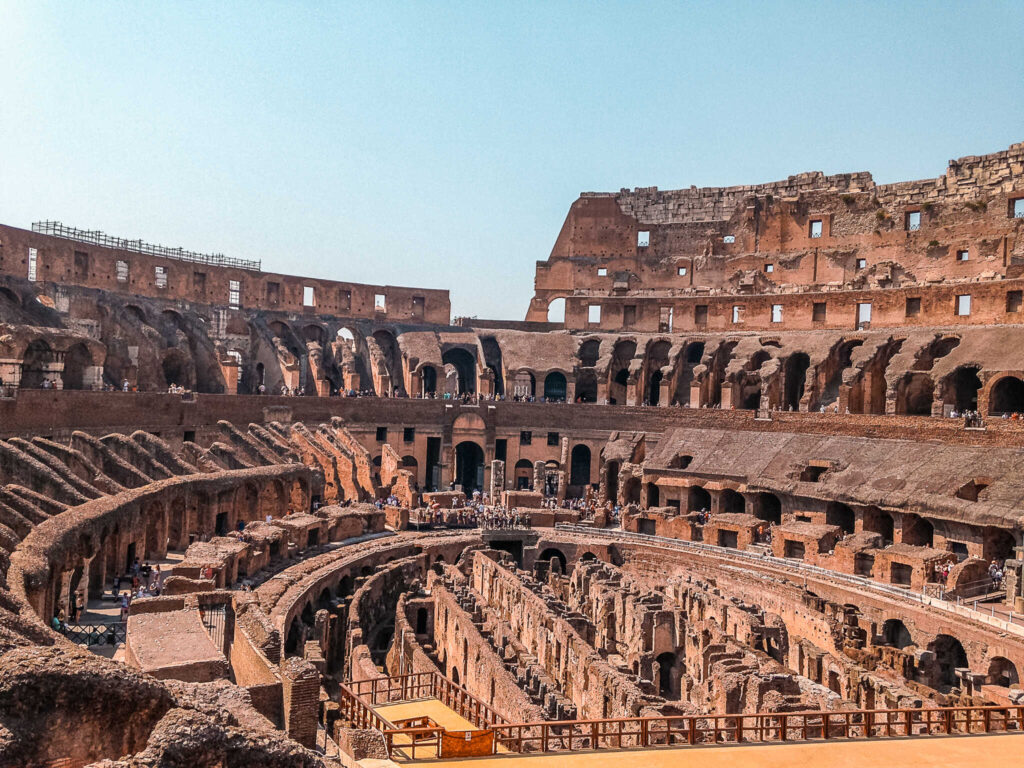
Just next to the Roman Forum, the Colosseum is undoubtedly one of the most famous monuments in Europe and an essential stop on any Rome itinerary. This majestic structure has almost 2,000 years of history and was the most incredible amphitheater of the Ancient Roman Empire.
In fact, over 50,000 people at once sat inside the Colosseum watching the gladiator games back in the days. During these games, the gladiators fought one another as well as exotic animals. Many gladiators were slaves and criminals who occasionally had a chance to fight for their freedom.
For the best experience, book a tour of the Colosseum so that you can fully understand what you’re seeing. This will also allow you to skip the long lines at the entrance gate.
If you’re interested in more tips for visiting the Colosseum, take a look at my complete guide!
On some tours, you can even see exclusive areas such as the underground space where the gladiators used to live. This is a great way to fully immerse yourself in the history of this place! You can also walk through the Colosseum Museum for more information.
To get to the Colosseum, take the Metro Line B to the “Colosseo” stop. You can also easily reach this place by foot from other famous Roman monuments such as the Pantheon or the Trevi Fountain.
Submitted by: Jiayi Wang from The Diary of a Nomad
Pantheon

Intact for almost 2,000 years, the Pantheon is an ancient Roman temple in modern-day Rome, Italy. It’s one of the most famous ancient places in Europe and is now a Catholic church. The Pantheon is widely regarded for its massive dome, the largest for several centuries after its completion.
It’s a beautiful work of architecture, and one of the best-preserved structures from ancient Rome. The Roman Empire had been at the peak of its prosperity during the rule of Emperor Augustus when it was built around 27 B.C. Augustus wanted to create the Pantheon as a sanctuary to worship the various gods of the Romans, and it was reconstructed about 126 A.D. by Emperor Hadrian. However, as the Roman Empire moved to Christianity, it was converted into a Catholic Church.
It has a wide, porticoed square patio on the outside of the Pantheon, a triangle pediment on top of the main entrance, and detailed Corinthian columns.
The inside has a single circular space, with another columned portico facing the circular domed chamber. The famous dome at the top is made of concrete with a circular window, which allows light inside from the sky. Now, the building is a museum, located near Piazza Navona and is free to visit during its daily open hours.
Ostia Antica
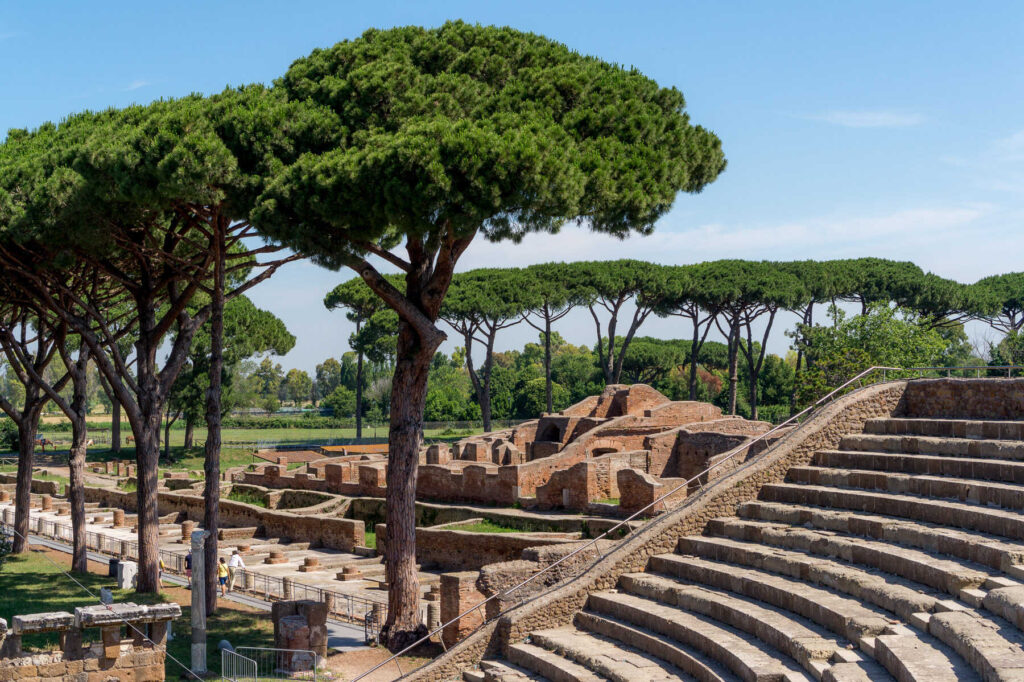
Ostia Antica is a vast archeological site that showcases the remains of ancient Rome’s harbor city. Established around 620 BC near the salt flats by the Tiber river’s mouth, Ostia developed to become a flourishing city and a lively harbor and commercial hub.
After the fall of Rome, the city was eventually abandoned. Fortunately, the mud that covered it allowed today’s archeologists to unveil a well-preserved town with buildings dating back from ancient times. The old theater, which boasts impressive acoustics, hosts music concerts.
Ostia Antica is only a half-hour away from Rome’s center. You need to take the commuter train from Piramide (Porta San Paolo) and ride six stops to get there. The regular public transport card or bus ticket covers this train line.
As the archeological site is extensive, consider showing up for a visit early in the morning. Wandering along this ancient places in Europe’s ruins can easily take four to five hours. Also, wear good walking shoes rather than flats or flip-flops to be able to explore all nooks and crannies of this citadel.
Most of the ruined dwellings don’t have a roof, so you’ll have to put up with direct sunlight for hours in a row. Wear a hat and plenty of sunscreen. There is a cafeteria inside the park, but bringing your own water and snacks could be a good idea. The visit to Ostia Antica is probably the best day trip from Rome you can take without hiring a car.
Submitted by: Violeta Matei from Violeta’s Travel Blog
Read More: Your Guide for One Day in Pisa
Ruins of Pompeii

If you find yourself in southern Italy, make sure not to miss the ruins of Pompeii.
You’ve probably heard the story: one beautiful October morning in the year 79 A.D., the residents of Pompeii were going about their business when they saw a giant mushroom cloud coming out of the nearby mountain. What ensued was an explosive volcanic eruption of Mount Vesuvius, which blanketed the city of Pompeii in 6 meters of ash and debris. Nearly all of the city’s 12,000 people suffocated to death, buried in the ash.
It sounds like a really morbid place to visit, and in some ways, it is. However, it’s a marvel to visit for any person with any curiosity and an absolute must-see destination.
Take a guided tour to learn about the fascinating, turbulent history and preservation of this ancient city. You will see the innovative–though deadly–lead piping, “fast food” restaurants, public baths, the main square and temple, and even some brothels. Allow yourself to take in the mosaic floors and wall carvings remarkably well preserved from nearly two thousand years ago.
Perhaps the most famous “attraction” here are the plaster body casts. In 1860, when Giuseppe Fiorelli started excavating the site, he realized the ash’s cavities were in the Pompeii residents’ exact shape when they died. He got the idea to carefully inject those cavities with plaster, let them harden, and dig them out. The result is truly incredible.
You can get to Pompeii easily from Naples or make it a long day trip from Rome. Take a private car, public transportation, or a guided tour from either Naples or Rome.
The artwork and artifacts were removed from Pompeii, so check those out at the Archaeological Museum in nearby Naples. You can also visit nearby Herculaneum, a lesser-known city that was also destroyed by Vesuvius.
Submitted by: Constance from A Well-Read Wanderer, specializing in literary travel guides
Herculaneum
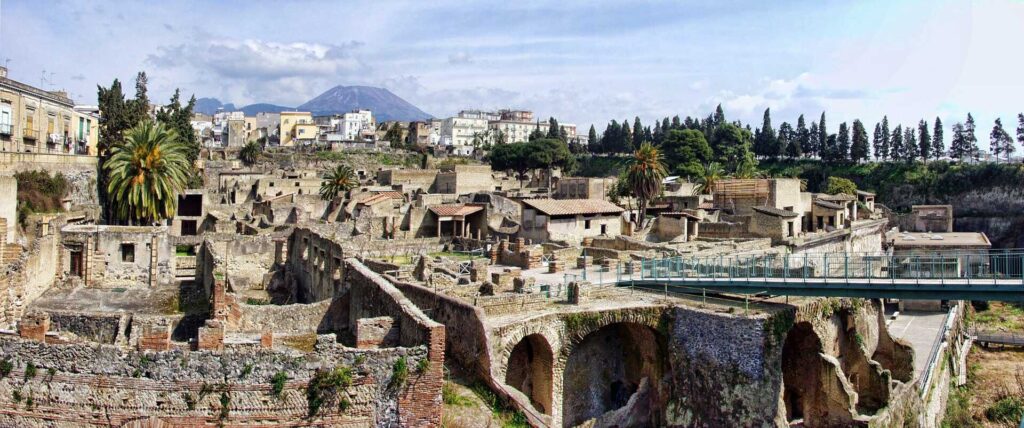
Herculaneum often gets overshadowed by more-popular Pompeii. But the second of the ancient sites in Europe on Italy’s Campania coast – similarly preserved by a blanket of ash when Mount Vesuvius erupted in 79 A.D. – is every bit as impressive.
Herculaneum is one of the most important archaeological sites in Europe. Once a bustling hub for the Roman elite, it was totally destroyed by the fateful eruption. Many villas, Roman-style mosaics, courtyards, sculptures, and other artworks were preserved in the process. Only a small part of the site has been excavated to date, and you continuously hear news stories about more precious finds being unearthed.
Visiting Herculaneum and walking the ‘streets’ is an entirely immersive experience. The detail in the glass mosaics and marble facades (Herculaneum was a much wealthier town than Pompeii and thus more opulently decorated) is simply stunning. Some of the more exciting parts of the sprawling complex include the ancient apothecaries, bars, and food stands that all provide a window onto daily life and commerce in Ancient Rome.
Herculaneum is easy to visit as a day trip from Naples. To get there, simply take one of the frequent passenger trains departing from Central Station. Travel time is just over 20 minutes, and the fare is less than 10 Euro.
Herculaneum has a large footprint, and there are lots of little nooks and crannies to explore, so it’s recommended to set aside at least three hours to do the site justice. It’s worth buying your Herculaneum tickets online in advance to avoid waiting in line when you arrive. For an in-depth explanation of the site, hire a guide – or else use the free information booklet provided at the ticket desk to show yourself around. It’s incredibly detailed and thorough.
Remember to bring snacks and water with you. Sun protection gear and bug spray are essential if you’re visiting in the warmer months, as most of the area is exposed and mosquitoes are an issue.
Submitted by: Emily from Wander-Lush
Read More: Your Guide to Teaching English in Italy with ACLE
Sassi di Matera

Built into the hillside’s calcarenite rock, the Sassi di Matera is a spectacular and compelling example of cave dwellings in the Mediterranean region. Located in today’s Matera, Italy, they were built thousands of years ago by generations of people living in caves. These caves’ first occupants were prehistoric Sassi people, with early traces of human life dating back to the Paleolithic period.
As the town of Matera started to develop around the Sassi, it was partially abandoned in the 1950s due to poverty and deteriorating safe living standards for residents – but the entire city has been transformed. The Italian Government, UNESCO, and the European Union stepped in to help preserve the impressive structures. The Sassi di Matera was named the European Capital of Culture for the year 2019.
If you want to see the Sassi di Matera for yourself, you can take a guided tour of Matera, which includes a visit to the Sassi. It lasts about 2 hours, and you can conveniently pair it with a visit to other nearby Matera landmarks.
Teatro Greco
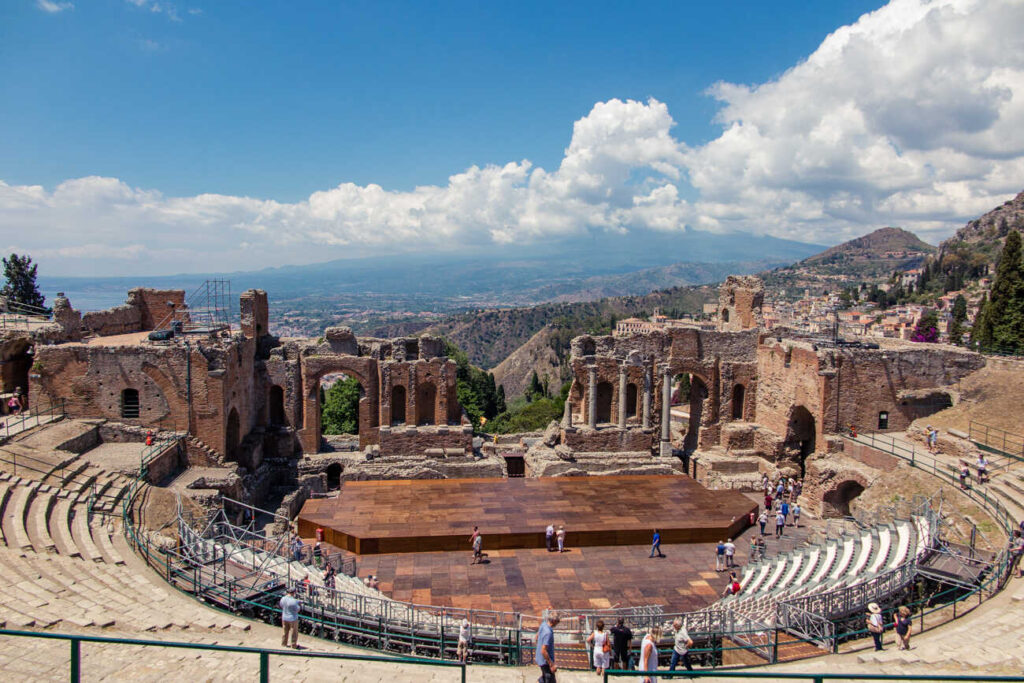
The Ancient Greek Theater, or Teatro Greco as it’s known locally, is one of Italy’s best-preserved amphitheaters. It’s Sicily’s second-largest such theater after the Roman Amphitheater in Syracuse.
The theatre in Taormina was built into a hilltop in the 3rd century B.C. by the Greeks to host musical and theater performances. Romans then modified it slightly and held other types of events, including the famous Roman Gladiator battles. Nowadays, events such as concerts still occasionally take place at this otherworldly venue.
Since the Greek Theatre is one of Taormina’s top sights, it’s easy to find. It’s located at Via del Teatro Greco – just turn left after walking through Porta Messina, the main gate to the Old Town.
The current entrance fee for adults is €10. You can wander around freely, admire the iconic structure as well as the views. Mount Etna can be seen as a backdrop to the theater on a clear day. With the theater’s position conveniently on a hilltop, the Ionian Sea views from there are absolutely gorgeous.
Of course, there are many more things to do in Taormina, including strolling through the Old Town and enjoying Taormina’s beaches. You can visit Taormina on a day trip, like from Catania, or stay overnight for the ultimate cultural immersion.
Submitted by: Veronika Primm from Travel Geekery
Mnajdra Temples
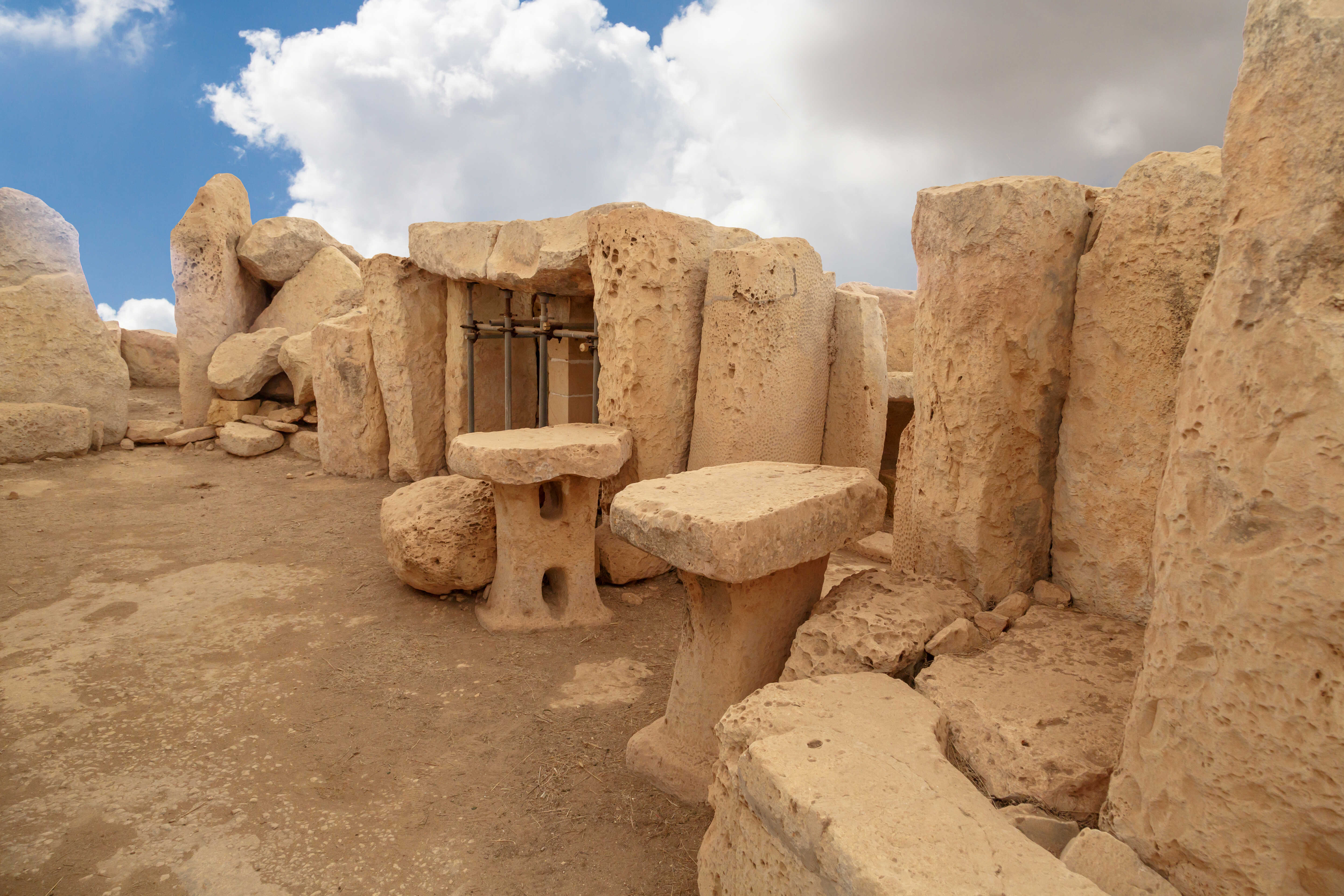
Built well before the Egyptians erected the pyramids, the Mnajdra Temple complex is one of the oldest limestone temples, and much of its original structure is still intact. The site is considered to be among the most important megalithic sites in Europe, and the temples themselves are the oldest free-standing buildings in the world.
The temple complex was used from about 3600 B.C. to 2500 B.C. but, the evidence suggests the temple itself was constructed in a few stages, between 3600 B.C. and 2000 B.C. The temple has three distinct parts–the South, the Central, and the East.
The temple’s architecture is close to that of Stonehenge, but the Maltese temple is much older. The South temple was probably used as a calendar or for astronomical observation since it’s aligned with equinoxes and solstices. Since they are still so well maintained, it has become a popular tourist and photography destination.
You can visit the Mnajdra Temples, as well as the Hagar Qim Temples, and a Visitors Center at Hagar Qim Park.
Ales stenar
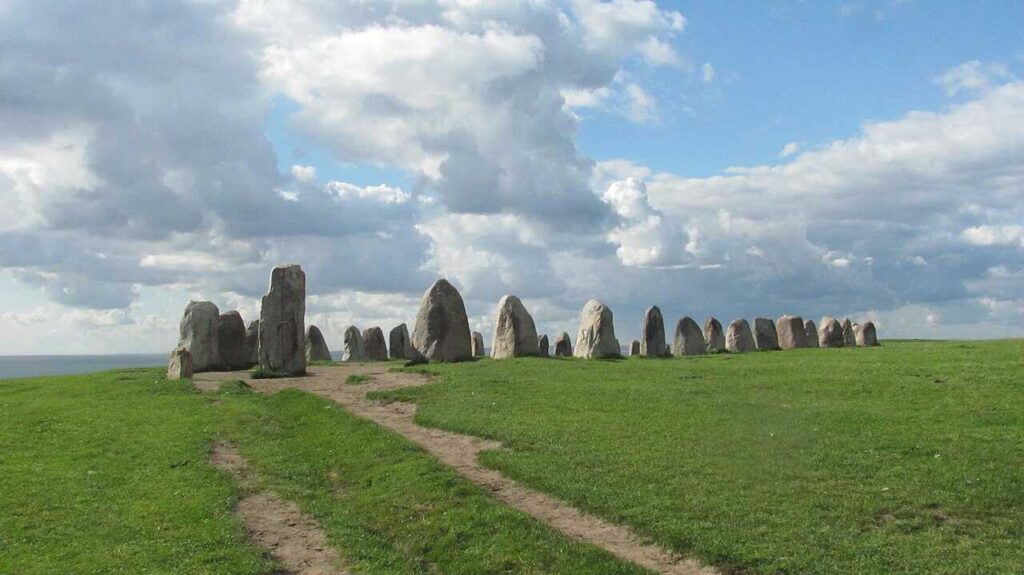
Ales stenar, also called Ale’s Stones, is one of the ancient places in Europe located in Scania, Sweden. This monument comprises 59 tall boulders standing erect and forming a 220 feet long boat-shaped structure. The stones at each end are larger than the rest and weigh about 5 tons each. Situated on a cliff, the Ales Stenar stands on a beautiful meadow overlooking the Baltic Sea.
This 1,400-year-old monument is believed to be a mythic king’s resting place, King Ale the Strong. The remnants of an ancient burial chamber dating back to almost 5,500 years have been found underneath Ales stenar. The monument is also said to have been used to observe the cycles of the moon.
The nearest bus station is at Kåseberga, which is located at a distance of 580 m. You can also take a train to Ystad and Bus 392 from there. The Ystad Tourist Office offers guided tours to Ales stenar. It is a nice picnic spot and is most beautiful during sunset. It is advisable to carry your food and water as you may not find any stores nearby. Being one of Sweden’s oldest and most mysterious structures and a beautiful scene altogether, the Ales stenar is a great place to visit in Sweden!
Submitted by: Neethu Nair from Our Backpack Tales
Eastern Europe
Pula Arena
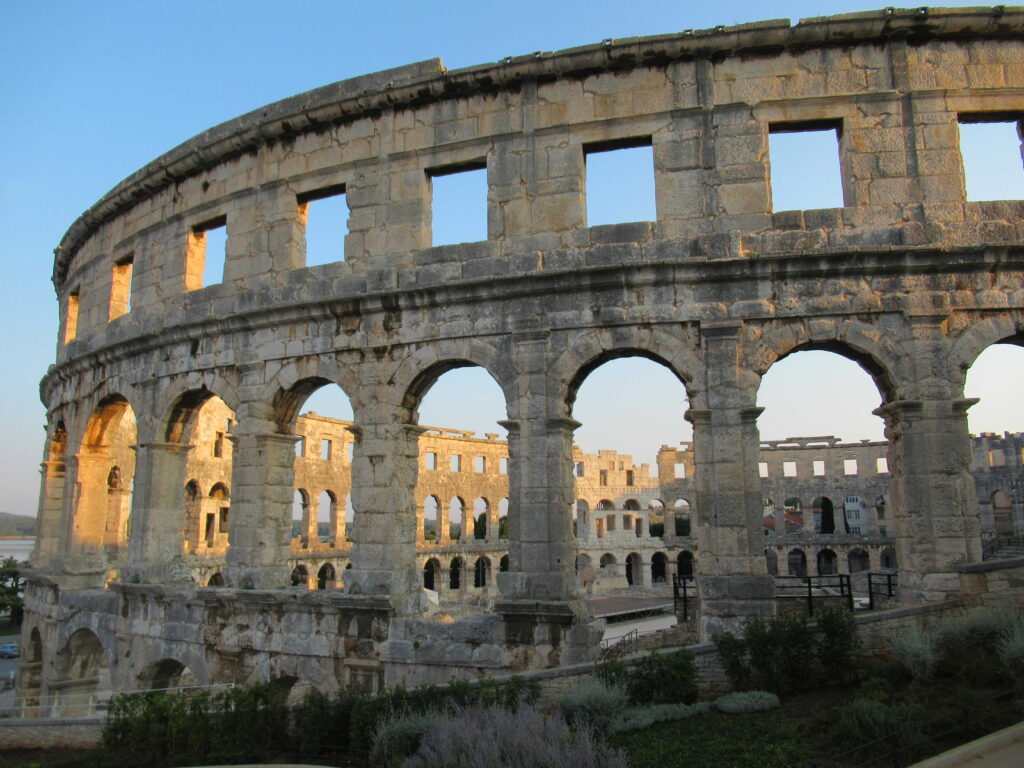
Pula Arena is a magnificent, 2000-year-old amphitheater in the heart of Pula, a Croatian city on the Adriatic Sea. Impressively, the building has survived centuries of use and bombing during World War II and is one of the best-preserved remaining Roman amphitheaters left in the world today. The Arena has come a long way from its ancient past of gladiator fights and, today, hosts regular concerts – Elton John has even played there!
Located just a 10-minute walk from both Pula Bus Station and Pula Train Station, you won’t miss this 100-foot tall and 400-foot wide amphitheater! Parking is available across the road at Car Park Carolina. Tickets cost 70 Kuna for adults and 35 Kuna for children, giving you access to the inside of the amphitheater as well as the underground tunnels containing a museum of its history. Visit at the opening time or towards the end of the day to avoid the crowds.
However, you can also walk around the entire outside for free, keeping to the public footpath. The Pula Arena design allows you to see inside to observe the ancient European ruins through the gaps in the amphitheater walls. Additionally, a couple of street cafes are located on the north and east sides that have seating areas looking into the amphitheater.
Pula Arena is also a beautiful building to photograph, by day and by night. The quietest time is at dawn, but the best time is at sunset to capture the golden light followed by the illuminated Arena.
Submitted by: Zoe from Zoe Goes Places
For more on Pula, check out my guides on the best things to do, the best beaches in Pula, and the perfect 3 day itinerary.
Diocletian’s Palace

Found right at the heart of Split, Croatia, Diocletian’s Palace is considered to be one of the most popular tourist attractions in the country. This UNESCO World Heritage Site is a brilliant example of the Roman architecture that occupies the seafront of Split.
The Palace was built in the 4th century by the Roman Emperor Diocletian and served as his retirement home for just a few years, from after his retirement in 305 A.D. until he died in A.D. 312. His complex was initially the core of an immense complex, which contained everything from the royal residence, to the baths, the mausoleum, and even the public square. Built closeby to his hometown of Spalatum, it was a testament to the incredible strength and prosperity of the Roman Empire.
Today, tourists can explore what remains of Diocletian’s retirement home and see why so many people are attracted to this beautiful architectural wonder. Since Diocletian’s Palace is the cornerstone of Split’s Old Town, you can wander around at your leisure. You’ll find shops, restaurants, and even apartments and hotels all inside the ancient walls of the Palace. You can read my guide to the best things to do in Split, Croatia here!
For more on Split, check out my guides on top day trips, the Old Town, beautiful photo spots, where to go for nightlife, and the best beaches in Split!
Read More
- Your Guide for One Day in Trogir
- The Best Things to do in Šibenik, Croatia
- The Best Beaches in Šibenik, Croatia
- Your Guide to Create Stunning Mixbook Travel Photo Books
Acropolis
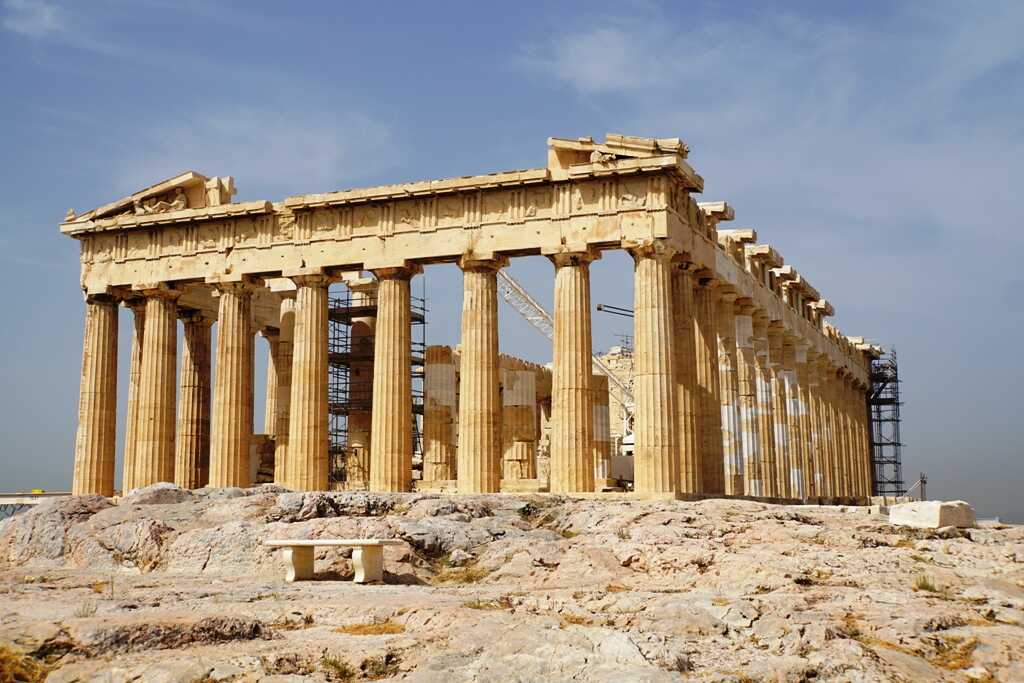
The Acropolis is the iconic ancient citadel perched on a rocky outcrop overlooking the city of Athens. Its name comes from the Greek words ‘akro’ and “polis’ meaning ‘high city.’ The Acropolis consists of a number of buildings, built in the 5th century B.C., for Athena, the patron goddess of the city.
The most famous building is the Parthenon, which is a huge marble temple dedicated to Athena. Other notable monuments include the Erechtheum – another temple, built on the spot where Athena’s sacred olive tree grew, the Temple of Athena Nike, and the Propylaea, the colossal entrance gateway.
The Acropolis is easily reached by metro – lines 1 & 3 to Monastiraki and line 2 to Akropoli.
Plan an early start to beat the crowds and the heat or visit late in the afternoon. Entrance tickets cost €20 (summer) and €10 in the winter. If you plan to visit many sites, the €30 combo ticket is good value and valid for 5 days. Buy tickets online to avoid queues.
The Acropolis stones have been worn smooth over time, so wear flat shoes with a good grip. There is little shade, so use sun protection cream and a hat. And make sure to take a bottle of water because exploring the Acropolis is thirsty work.
Submitted by: Chrysoula Manika from Athens and Beyond
Knossos

Knossos is a wonderful place to visit, just outside of the capital of Crete, Heraklion. This series of Minoan palaces is now a fantastic insight into a time that is otherwise lost forever. Walkthrough abandoned hallways and great halls and see wall paintings and sit on the steps of the theatre.
This Greek city is somewhere to come and really feel human history. From its first excavations by British archaeologist Arthur Evans around a hundred years ago, this is believed to be one of Europe’s oldest cities, occupied from Neolithic times up to around the 5th century.
Today just wandering through the site will allow glimpses of the beautiful world. If you have time, then combine the visit with a trip to the Archaeological Museum in Heraklion, where many of the treasures found here are not housed. It allows even more insight into what an opulent and vibrant world this was here at Knossos. There’s a small restaurant onsite and a gift shop too.
There is public transport to get out to Knossos, but like many Crete places, it is easier to get around using public transport. Stay at one of the great family resorts in Crete, many of which are nearby, to be able to really enjoy the time here without feeling rushed.
Submitted by: Nichola West from Family Hotel Expert
Ancient Roman Theater of Philippopolis
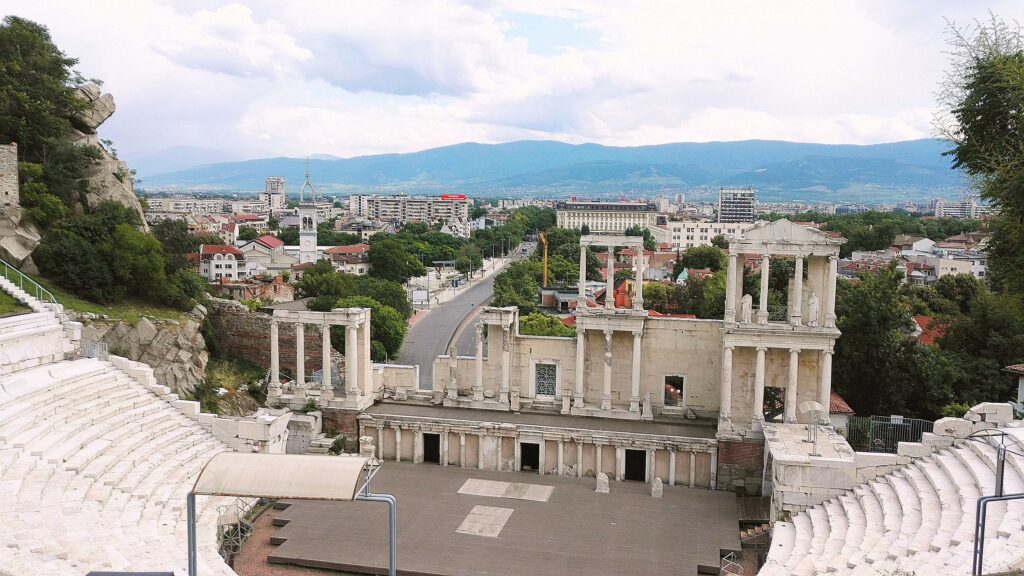
This is one of the less known historic sites, located in Plovdiv, known as the most ancient continually living city in Europe, the second-largest city in Bulgaria. The theater is built in a typical semi-circled style, around 90 A.D. Unlike many other ancient Roman theatres, this one has been hidden underground in one of the Plovdiv hills–the triple hill of Trimontium. And it was occasionally discovered in 1970 due to a landslide.
Since then, the Ancient Roman Theater was renewed and turned into one of the Bulgarian landmarks. Today, it features a semi-circle shaped seat part, a stage for performances, and ruins of an ancient Roman construction behind it. The theater is not only a splendid site with historical value, but its satiation on the southern slope of Trimontium reveals a stunning panoramic view of Plovdiv and the Rhodope Mountains in the background.
Once you arrive in Plovdiv–just 1 hour and 30 minutes by bus from the capital Sofia–you can easily walk to the city centre, and then ascend to the hills of Trimontium. This area is where the Old Town of Plovdiv is situated, and the Ancient Roman Theater perfectly fits the whole place, so you can just include it as a part of your Old Town walk. The entrance fee is 5 BGN, and the gate is on the upper side of the theater. You can enter inside, walk around and enjoy fantastic photo opportunities.
But that’s not all. From late spring until early fall, there are regular productions on the theater stage of various kinds. Folklore pieces and dances, symphonic and opera concerts, and even rock-metal live shows are performed. The theater is a favorite place for many Gothic metal bands. You just have to plan a more extended trip to Plovdiv–a city full of so many things to present, and definitely include the Roman Theater as a part of your itinerary.
Submitted by: Krasen Jelyazkov from Journey Beyond the Horizon
Ephesus

Located only a couple of kilometers away from Selcuk, on the Ionian coast, Ephesus is one of the most impressive archeological sites in the world. It got added to UNESCO World Heritage Site in 2015. Ephesus is also a popular day trip among cruise holidaymakers, as one of the cruise stops is Kusadasi port.
The history of Ephesus dates back to the 10th century B.C., according to Greek Mythology. Since then, the city was under the control of many empires, and in 129 B.C., it came under the Roman empire. Ephesus as a town was a working port and a major center for commercial trade during this era. In the Roman period, the Temple of Artemis was rebuilt, which can still be seen in the present-day Ephesus. The Temple of Artemis was one of the Seven wonders of the ancient world.
Curetes street is one of Ephesus’ three main avenues, and it connects Celcius Library to the Hercules Gate (one of the entrances). It’s an incredible feeling to walk down Curetes Street overlooking the magnificent Celcius Library, built in 117 A.D. Celcius Library is the most photographed part of Ephesus, and you will know why when you stand between the towering columns and intricately carved ceilings. The library was one of the largest in ancient times and used to store 12,000 scrolls.
Great Theatre is yet another impressive amphitheater that had a seating capacity of 25,000 spectators. Other monumental ruins inside Ephesus include the Temple of Hadrian, terraced houses, Odeon Theatre, the Basilica of St.John, Ephesus archeological museum, and Ephesus amphitheater. If you are a history buff or architecture/archeology lover, a day trip to Ephesus is a must!
Submitted by: Anuradha from Country Hopping Couple
Which of these ancient places in Europe will you be adding to your bucket list?

